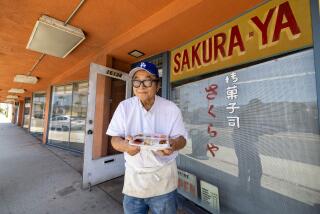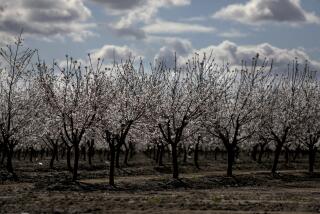Japanese Market a Tough Nut to Crack, but Almonds Do It
When 166 Japanese tourists descended on the Queen Mary in Long Beach for lunch the other day, they seemed like ordinary visitors. But a few days later, when they showed up in a San Joaquin Valley almond orchard with a television crew and some Japanese actresses, it was clear that they were a little different.
The tourists were Coca-Cola salesmen in Japan--and they help distribute California almonds to thousands of Japanese consumers.
Coke and almonds? They make a nice snack combination, but they make an even sweeter marketing twosome for the California Almond Growers Exchange.
The Sacramento-based growers cooperative uses Coca-Cola bottlers to distribute its nuts to Japanese retailers, an unusual and innovative approach that circumvents Japanâs traditional distribution maze.
âWith our system, we sell directly through the Coca-Cola bottlers direct to retailersâ eliminating two or three middlemen, explained Walter Payne, the growers exchangeâs vice president for sales and marketing. âThe product gets to consumers at a much more reasonable price.â
Today, Japan is the second-largest importer of California almonds after West Germany. In 1986, the growers of the California exchange sent $70 million worth of almonds to Japan, where they are the second-most popular nuts--after peanuts.
The salesmen were in the orchard, near the town of Ripon, to take part in the filming of a Japanese TV documentary about California almonds. Besides its public relations efforts, the exchange attributes part of its success to coming up with products to suit Japanese tastes--such as slivered almonds mixed with dried baby sardines, a popular school lunch snack. Some of the others: almond tofu, almond powder drink (dissolved in milk or water), almond sausage, almond salami, almond noodles and almond soap.
The Japan External Trade Organization likes to use the almond growers cooperative as a model of how American businesses can successfully penetrate the Japanese market. But almonds, unlike rice and citrus fruits, are not grown in Japan so the nuts face no protectionist regulations there.
In addition, the almond growersâ success is due largely to the work of one man--Masuo Koga, manager of the exchangeâs Tokyo office. Koga established what he describes as âa one-desk officeâ in Tokyo in 1969 and doggedly created a Japanese market for California almonds, which are sold under the Blue Diamond label.
Key to Blue Diamondâs success has been streamlining the distribution of almonds in Japan.
Distribution of products in Japan is a multi-level process and goods typically pass through at least four companies before arriving at retail stores. âWhat was the best wholesaler distribution?â Koga asked himself as he mulled the problem. âNone of the traditional.â
So in 1971, he turned to Japanâs 17 Coca-Cola bottlers. Koga said during a recent visit to Los Angeles that the bottlers have 20,000 salesmen and that Coke is sold in 1.1 million retail outlets in Japan. Today, almonds are sold in 200,000 Japanese stores, and Koga is aiming for 400,000 by 1990.
More to Read
Eat your way across L.A.
Get our weekly Tasting Notes newsletter for reviews, news and more.
You may occasionally receive promotional content from the Los Angeles Times.










